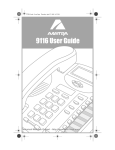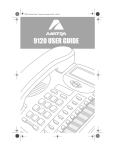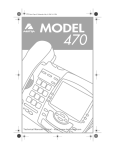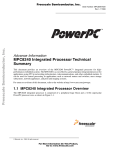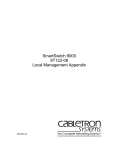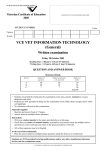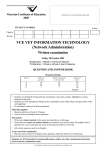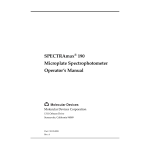Download Aastra 9110 User guide
Transcript
9110 2 EF.book Page 0 Monday, March 29, 2004 3:51 PM 9110 USER GUIDE Table of Contents 9110 2 EF.book Page i Monday, March 29, 2004 3:51 PM Table of Contents Introduction .................................................................................................. 2 Emergency service Feature ........................................................................ 2 Unpacking your phone ................................................................................ 2 Key Descriptions ......................................................................................... 3 Basic Installation.......................................................................................... 5 Making and Answering Calls ...................................................................... 8 Making a call ............................................................................................... 8 Answering a Call ......................................................................................... 8 Using the Hold Key...................................................................................... 8 Making a Handsfree call.............................................................................. 8 Muting a Handsfree call .............................................................................. 9 Using the Redial ......................................................................................... 9 Adjusting the Handset and Speaker volume ............................................... 9 Adjusting the Ringer volume ....................................................................... 9 Set Indicator light ........................................................................................ 9 Memory keys .............................................................................................. 10 Saving numbers into memory keys ........................................................... 10 Labeling the memory keys ........................................................................ 10 Making calls from memory keys ............................................................... 11 Deleting memory keys............................................................................... 11 Saving features in memory keys ............................................................... 11 Using features keys ................................................................................... 12 Using the Dataport .................................................................................... 12 Troubleshooting ......................................................................................... 12 i 9110 2 EF.book Page 2 Monday, March 29, 2004 3:51 PM Congratulations..... on the purchase of your 9110 telephone. This guide contains operating information for your 9110. The 9110 is an advanced single-line telephone, that offers the following features: Introduction Introduction • Handsfree (speakerphone) with mute capabilities • 7 speed dial positions for frequently called numbers or feature access codes • Last number redial • Loop powered Emergency Service Feature The Model 9110 will continue to provide basic telephone service during a power failure. Unpacking your phone Along with this user guide, the following items are included with your telephone. Handset cord Handset Telephone Memory key card and plastic lens Number card and plastic lens Regulatory sheet Telephone stand Telephone line cord 2 Introduction 9110 2 EF.book Page 3 Monday, March 29, 2004 3:51 PM Key Descriptions Handset Set Indicator Light Red Flas Sav ial h e Ringer Switch M ut e Volume Bar Dial Pad Handsfree/Mute 7 Memory Keys 3 Data Jack 9110 2 EF.book Page 4 Monday, March 29, 2004 3:51 PM Key Description Set Indicator Light Flashes when the telephone rings, or when a call is on hold; lights up when a message is waiting. See Set indicator light on page 9 for more information. 7 Programmable Keys Stores a number or feature for easy access. N Ends an active call. It will not hang up a call that is on hold. O Places calls on or off hold. See Using the Hold Key on page 8 for more information. R Sets the handset and speaker volume while on call. c Activates the speaker and microphone so you can listen and talk without using the handset; also mutes the microphone so that your caller cannot hear you (the light indicator will ßash when the microphone is muted). a Use with network features such as Call Waiting and Three Way Calling (ßash is also referred to as link). b Dials the last number dialed out on the telephone. See Using Redial on page 9 for more information. K M Use to store numbers in memory keys. Introduction Keys Memory keys store numbers. See Memory keys on page 10. 4 Basic Installation 9110 2 EF.book Page 5 Monday, March 29, 2004 3:51 PM Basic Installation 1. Connect the Handset Cord 2.Connect the Line Cord Attach one end of the coiled handset cord to the handset and the other end to the handset port on the back of the telephone. Plug one end of the telephone cord into on the back of the telephone and the other end to the phone jack. Route the handset cord along the groove leading off the side of the telephone as shown in the illustration. 1 3. Attach the Stand for Desk Use If you plan to mount the telephone on the wall, you do not need to attach the stand. Lower the stand as shown below into the slots on the back of the telephone. 5 Slide the stand in the direction shown below until it clicks into the locked position. 9110 2 EF.book Page 6 Monday, March 29, 2004 3:51 PM Route the line cord along the groove on the telephone stand as shown in the illustration. It is recommended that you use a wall-mounting plate which is available through your telephone company or a local retailer. You will Þnd it easier to wall-mount the telephone if you purchase a short telephone cord and use it in place of the long telephone cord. Basic Installation 4. Attach the line cord to the telephone stand 5. Wall mounting installation Coil the telephone cord into the space provided on the back of the telephone. Line up the keys on the wall mounting plate with the key holes on the back of the telephone. Place the telephone onto the wall mounting plate, and then push down to secure the telephone into place. 6. Wall mounting installation with stand The telephone can be wall mounted at an angle (tipped back slightly) by using the stand. Screw the stand to the wall using the two round holes in the stand (wedge part down, holes up). Connect line cord to the telephone. Attach the telephone stand. 6 Basic Installation 9110 2 EF.book Page 7 Monday, March 29, 2004 3:51 PM 7. Insert the number card on your telephone 8. Insert the Memory key card on your telephone Write your telephone number on the number card. This card contains the feature names for the dedicated keys and label identiÞcation spaces for the seven programmable memory keys. Place the number card into the slot underneath the handset cradle on the on the telephone. Place the card into the memory key card slot on the telephone. Gently bend the clear plastic lens Gently bend the clear plastic lens and place it on and place it on top of the number top of the memory key card in the slot. card in the slot. For information on programming memory keys, refer to Memory keys on page 10 Redi Flas al h Save M ute Avoid potential electrical shock hazard and damage to the telephone, by using the manufacturer-supplied parts. SpeciÞcally, only use a two conductor modular line cord. Substitution of non-approved parts will void the Aastra Telecom Inc., warranty. If you have a question about your installation or safety concerns, please call 1-800-574-1611 to speak with our representative. 7 9110 2 EF.book Page 8 Monday, March 29, 2004 3:51 PM Making a call With your telephone you can make and answer calls using your handset or c for speakerphone capabilities. To make a regular call: 1. Lift the handset or press c. 2. Enter the number using the dial pad. Answering a Call To answer a call: 1. Lift the handset or press c. Making and Answering Calls Making and Answering Calls Using the Hold Key To put a call on hold and take a call off hold: 1. Make or answer a call. 2. Press O. The set indicator light will ßash quickly to indicate there is a call on hold. 3. To retrieve the call, press O or c. If you don’t retrieve the call within 15 minutes, the call is automatically dropped. Note: The 9110 automatically releases a call on hold when a person on an extension telephone on the same line picks up the call. If you don’t hang up the handset after you have put a call on hold and that call is picked up by someone at another extension, the call is taken off hold but remains connected to your telephone. If this happens, any background noise from your area will be heard by the caller and the person at the other extension. Making a Handsfree call You don’t have to use the handset to use your telephone. Instead, you can use Handsfree mode to place a call, or you can switch to Handsfree mode while a call is in progress. To dial without picking up the handset: To switch to a Handsfree call: 1. Press c. 1. Lift the handset. 2. Dial a number using the dial pad. 2. Dial a number using the dial pad. 3. When the call is over, press N. 3. To switch to handsfree, press c. 4. Hang up the handset. 5. When the call is over, press N. Note: After ending a handsfree call, you may Þnd you must wait for at least 2 seconds prior to pressing c to obtain dial tone and initiating your next call. This time is required to allow the network to completely disconnect your last call. 8 Making and Answering Calls 9110 E2 UG.fm Page 9 Friday, May 21, 2004 9:39 AM Muting a handsfree call You can turn off the microphone so that the caller can’t hear you but you can still hear the caller. Muting a call only works when you are in Handsfree mode. To mute a handsfree call: 1. Press c. 2. Without lifting the handset, make a call. 3. To turn off the microphone, press c. You can hear your caller but your caller cannot hear you. The light next to the key will flash to indicate the mute is on. 4. To speak to your caller, press c again. Each time you press c, you turn the microphone on or off. 5. When the call is over, press N. Using Redial Pressing Redial dials the last number dialed. To make a call using Redial: 1. Lift the handset or press c. 2. Press b. Adjusting the Handset and Speaker volume Press the left or right side of the volume bar R to adjust the volume on the handset or speaker. The handset volume resets to factory set volume level after each call. The speaker volume remains at the level selected until the next time you change it. Adjusting the Ringer Volume The ringer volume is controlled by a three position switch on the side of the Model 9110. The ringer volume can be set to low, medium, or high. Set Indicator Light The set indicator light, located on the top right hand corner of the Model 9110, flashes and illuminates to provide information as follows: 9 Set indicator light flashes very quickly. Incoming call. Set indicator light flashes quickly. (2 pulse/sec.) Line is on HOLD. Set indicator light flashes slowly. (1 pulse/sec.) Message Waiting*. 9110 E2 UG.fm Page 10 Friday, May 21, 2004 9:39 AM Saving numbers into memory keys You can save up to 7 speed dial numbers of your customers, business associates, or anyone you call frequently in 9110’s seven memory keys. To save a telephone number in a memory key: 1. Lift the handset or press c (the dial tone signal will continue while you save). 2. Press K. You will hear a two tones. 3. Press the desired memory key you wish to store the number to. You will hear one tone. 4. Use the dialpad to enter the number. You can enter any number up to 30 digits. If you need to enter a 2 second pause (between your voice mail number and a password, for example) press the O key. To program a number or code that uses Flash, press the a key. 5. Press K to save the number into the memory key. You will hear two tones. 6. Hang up the handset or press N. Memory keys Memory keys Note: In some operating environments, these steps must be completed within 20 seconds or the line will briefly disconnect. The telephone will not store digits to memory if this occurs and you will have to repeat the steps above to save to a memory key. Labeling the memory keys Your Memory key card has label identification spaces (shaded in grey) for each of the seven programmable memory keys. Write the name of the autodialer or feature on these spaces when you program a memory key. Red Flas Sav ial h e M ut e 10 Memory keys 9110 2 EF.book Page 11 Monday, March 29, 2004 3:51 PM Making calls from memory keys To call from a memory key: 1. Lift the handset or press c. 2. Press the memory key to obtain the number you wish to dial. Deleting memory keys To delete a memory key: 1. Lift the handset or press c (the dial tone signal will continue while you delete). 2. Press K. You will hear two tones. 3. Press the desired memory key you wish to delete. You will hear a different tone sound. 4. Press K. You will hear two tones. 5. Hang up the handset or press c. Saving features in memory keys For easy access, you can save the feature codes of telephone company services in your memory keys. This works well with network features such as Call Forwarding and Call Return. Some features require an On and Off code in two separate keys, while other features are stored on only one key. The following procedures show you how to save both an On and Off code. To save a Feature On code: To save a Feature Off code: 1. Lift the handset or press c (the dial tone signal will continue while you save). 1. Lift the handset or press c (the dial tone signal will continue while you save). 2. Press K. You will hear two tones. 2. Press K. You will hear two tones. 3. Press the desired memory key you wish to store the feature code to. You will hear one tone. 3. Press the desired memory key you wish to store the feature code to. You will hear one tone. 4. Enter the telephone company feature code for turning the feature on.† 4. Enter the telephone company feature code for turning the feature off.† 5. Press K to save the feature code into the memory key. You will hear two tones. 5. Press K to save the feature code into the memory key. You will hear two tones. 6. Hang up the handset or press c. 6. Hang up the handset or press c. 7. Label the memory key. 7. Label the memory key. Note: In some operating environments, these steps must be completed within 20 seconds or the line will brießy disconnect. The telephone will not store digits to memory if this occurs and you will have to repeat the steps above to save to a memory key. †Contact your telephone company for the appropriate feature codes. Some may require subscription to Custom Calling Features. 11 9110 2 EF.book Page 12 Monday, March 29, 2004 3:51 PM When a memory key is programmed with a feature code, you can use the memory key to activate or deactivate the feature. To turn a feature on or off: 1. Press the memory key where you stored the desired feature. 2. Lift the handset or press c.The feature code is dialed out, which turns the feature on or off. Troubleshooting Using feature keys Using the Dataport Located on the right hand side of the Model 9110, the dataport can be used to connect another device such as a fax machine or computer modem to the phone. Plug one end of the line cord to the phone and the other end to the device to be connected. The dataport can only be used when the phone is not in use. Troubleshooting The telephone wobbles. Check that the handset cord is placed in the channel between the stand and the telephone. See the illustration on page 6. I cannot program a memory key. Some of the memory keys may be factory-programmed. These keys are locked and cannot be erased or reprogrammed. How do I answer Call Waiting? To answer a Call Waiting call, press a. You may have to subscribe to a Call Waiting† service to use this feature. I do not hear dial tone. Check that the line cord and receiver cord are securely plugged into the proper jack and are not damaged. I hear dial tone or a recorded message when I am saving a number into a memory key. This is normal. Since the 9110 is programmed off hook, a dial tone will continue while you save or erase numbers or codes in memory keys. You may even hear beeps or a recording. These sounds do not interfere with programming. In some operating environments, these steps must be completed within 20 seconds or the line will brießy disconnect. The telephone will not store digits to memory if this occurs and you will have to repeat the steps to save to a memory key. I can’t get dial tone using the handsfree speakerphone after hanging up from a previous call. In some operating environments, you must wait for at least two seconds after ending a call before initiating your next call. †This service may have a different name in your area — contact your telephone company for details. 12 Index 9110 2 EF.book Page 35 Monday, March 29, 2004 3:51 PM Index C Calling from a memory key 11 from the Redial List 9 Calls handsfree 8 holding 8 muting 9 D Deleting memory keys 11 Directory 10 H Handsfree 8 Helpful hints see Troubleshooting 12 Hold 8 I Installation 5 K Key descriptions 3 M Memory keys 10 cannot program 12 deleting 11 editing 11 making calls from 11 saving features 11 Mute 9 R Redial List 9 S Save key 4 Saving feature codes to memory keys 11 numbers to memory keys 10 T Troubleshooting 12 V Volume muting a handsfree call 9 9110 2 EF.book Page 13 Monday, March 29, 2004 3:51 PM GENERAL INQUIRIES If you have read the guide and you still have questions, call 1-800-574-1611 in Canada and the USA. In other areas, contact your telephone company. © Aastra Telecom Inc., 2004 41-0067-00 Rev 02
















